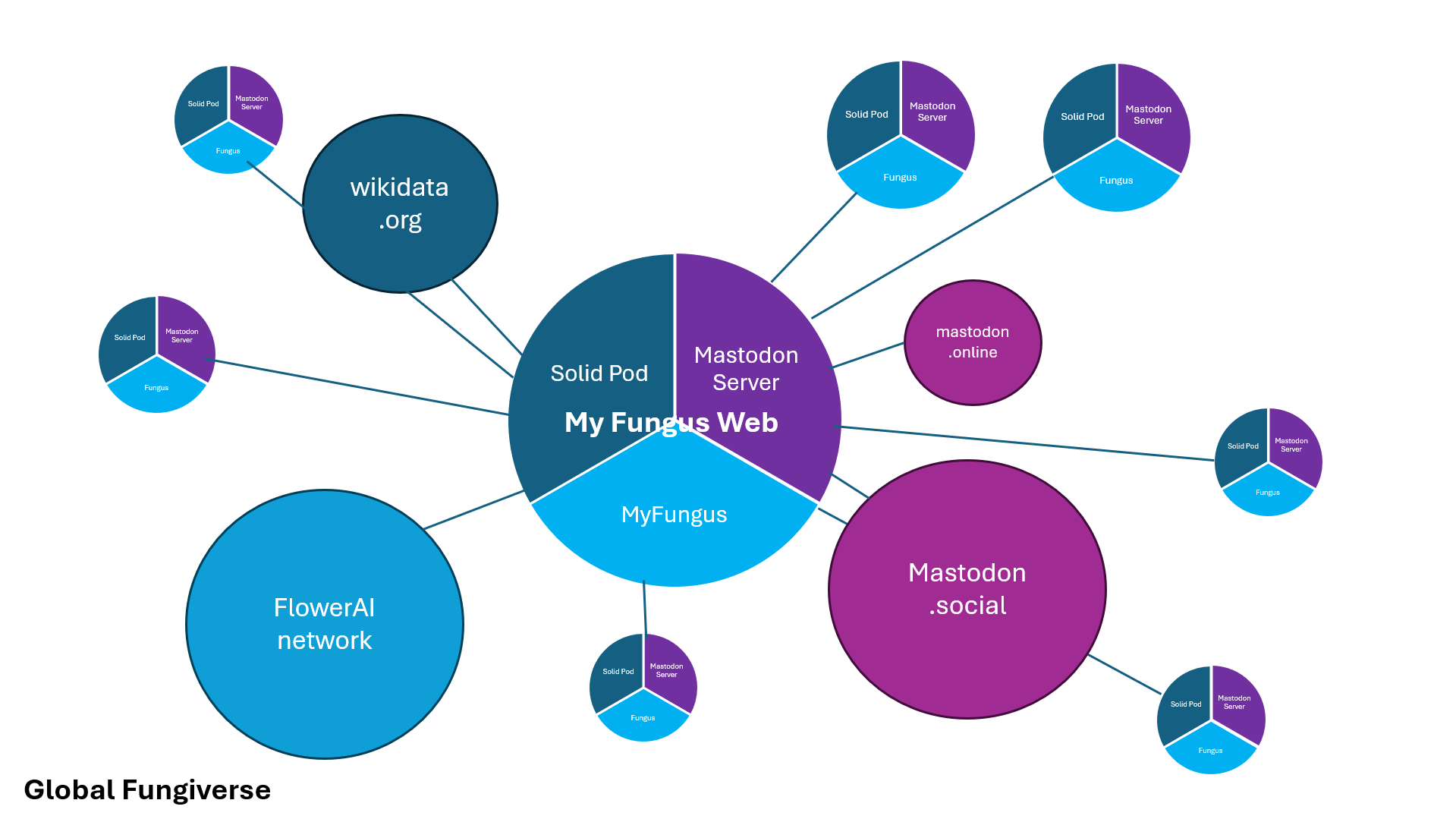
A fungus sits at the intersection of the social web (Mastodon, Pixelfed, Lemmy, etc.), the semantic web (knowledgraphs like Wikidata.org) and decentralized federated learning.
This means it represents the “computation web”-aspect in the above picture. Together with other similar agents, it result in a decentralized, federated web of AI agents that work on open, shared data and are open to communities. Everybody should be able to set up their own fungus service and help to grow an AI model of their choice. I call this the “fungiverse” or “mycelial web”.

A fungus web-service …
- answers user requests over the social web
- users are also able to insert knowledge via posting to a hashtag the fungus listens on
- writes and reads data from the semantic web to collaborate with other fungi agents (this would ideally done with decentralized technology like solid pods, or other knowledge graphs, e.g. like wikidata.org or an own fuseki server)
- develops a shared AI model (which is also written to the semantic web) based on decentralized federated learning (which would be ideally be based on something like FlowerAi, but isn’t at the moment).
The three parts can be thought of as a social network, a chat bot network and a knowledge graph (like a wiki for data), with all of the three aspects interlinked - the fungus drawing its data from the knowledge graph and being available in the social web as a bot, the social network to give access to the knowledge base and AI bots through bots, and the knowledge base, which can be viewed as a wiki with the bots that currently work on it and the comments from the social network. From a users perspective, the fungus appears as a chat bot interface (with the ability to view all bots its connected to and to which they are connected to etc.), the knowledge base would appear as a wiki like wikidata.org and the social network as a network like Mastodon.
The idea is that every user can install all of these three aspects on their own local PC to participate in the overall network (meaning having access to the social network, accessing global knowledge graphs and participating in decentralized learning to train their own bot).
Behaviour
In its behaviour its similar to that of a fungus (hence the name):

The shared model data can be thought of as the spores, which are also used by other fungi to adjust their models. The resulting AI chats available to the users are the “fruits” of the fungi.
Roughly, a fungi’s behaviour is defined by a protocol, for example SPORE.
The following fungus is able to make song recommendations to the user: https://github.com/bluebbberry/MusicRecommendationFungus
Here is a more technical description of a fungus and its incentives for human-fungus-interaction.


I feel like the point of metaphors is to explain something new with an idea that’s already familiar and understood
If you have to explain the actual content AND the metaphorical comparison you’re using to explain it, you’ve just kinda added a second thing to explain for very little communicative benefit
I like the aesthetic and sentiment of characterizating tech in this way, but I don’t think it’s particularly helpful
So its basically just a mastodon bot, a knowledge graph and an AI-model, who all work together.
The mastodon bot makes the functionality available to users (they can ask for song recommendations), the AI model is obviously trained and the knowledge graph is used to save the model and for collaborative communication between AI agents.
I’m not 100% sure whether it will be counter-productive or not, but maybe AI on the Fediverse could be a good thing. Like it could push the Fediverse forward (all big social networks nowadays have their own llms, ours should be federated of course). I think combining these three aspects (social web, semantic web/knowledge graphs and autonoumos agents) could be a cool thing. I have noticed how the narratives in the three departments are similar to one another (social web enthusiasts speak about walled gardens, data/knowledge enthusiasts about data silos and AI enthusiasts about big, centralized AI).
The following three resources point to how similar the approaches are:
But how to combine them? Maybe as a fungus?